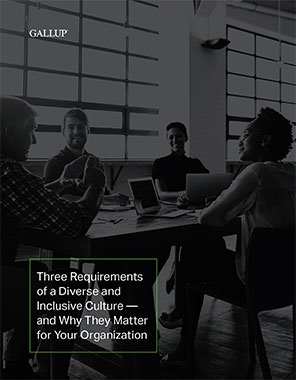Story Highlights
- Leaders can create the conditions for meaningful progress on DEI outcomes
- It requires examining the employee experience through a DEI lens
- DEI strategies need the right metrics and processes to sustain change
Workplaces globally have expressed a new or renewed commitment to diversity, equity and inclusion (DEI), largely related to social and political trends -- along with increasing awareness about the importance of DEI from a moral and business standpoint.
To this end, many organizations are re-evaluating their DEI strategies and goals, hiring for DEI roles -- especially Chief Diversity Officers -- and publicly pledging to support more diverse and inclusive workplaces.
There's no question these are necessary steps toward embedding DEI into an organization's culture -- that is, changing "the way work gets done" at an organization so every employee feels respected and included -- but it will take more for leaders to create the conditions for meaningful progress on DEI outcomes.
Studies from the Gallup Center on Black Voices find that one in four Black employees in the U.S. have reported experiencing workplace discrimination in the past year and that Black women are less likely to feel they are treated with respect in the workplace. Disparities in the employee experience represent real, and potentially significant, differences in the way workers approach their jobs and their teams. And with a lack of diverse representation in leadership and only 42% of U.S. managers strongly agreeing that they are prepared to have meaningful conversations about race with their teams, it's increasingly important for leaders to consider the employee experience through a DEI lens.
Leaders can turn good intentions into reality by creating an employee experience with formal structures, clear strategies and alignment to values that uses employees' perspectives to prioritize change and measure progress.
3 Actions to Help Leaders and DEI Ambassadors Create More Diverse, Equitable and Inclusive Workplaces
To improve DEI in the workplace, leaders need a strategy that combines their aspirational vision with the right metrics and processes to create change in a sustained and proactive way, rather than as a short-lived reaction to current events.
To get started, Gallup recommends three actions for leaders based on our advice and analytics for culture transformation and the employee experience.
1. First, identify DEI priorities based on a rigorous assessment of the organization's current state.
Leaders need quantitative and qualitative data to describe the current state of the employee experience. That's necessary for setting realistic, impactful DEI goals and timeframes -- such as increasing the percentage of women and people of color in leadership positions over the next five years -- or building formal mentorship programs to promote development and advancement more equitably.
Gallup's Inclusion Index measures the three fundamental qualities of inclusive cultures: respect, strengths and trust -- and it identifies how they correlate to other key workplace enablers such as engagement, innovation and agility. Some of Gallup's Inclusion Index clients ask employees deeper questions about belongingness and equity, or study turnover, pay, development, mentorship, and other key elements of engagement. However it's measured, data on the employee experience establish an objective and comprehensive baseline for each touchpoint of the employee life cycle.
2. Next, consider how the work will get done to create the organization's future state.
Plans achieve priorities -- and people achieve plans. Once DEI priorities have been identified, leaders should select a dedicated team to steer, execute and champion a strategy that's tailored to the plan. Expect significant cross-functional collaboration on all DEI efforts, whether lead by a Chief Diversity Officer, ERG leader, HR leader, DEI Committee leader, or other business leader.
Some of Gallup's clients have found that dedicated DEI teams are more effective when they have:
- a structured DEI charter detailing the purpose of the work, processes, goals and a shared understanding of what success looks like
- executive sponsorship from a credible and committed senior leader who is willing to champion DEI efforts with other leaders and across the organization
- worksteam leaders from different parts of the business with specific roles and responsibilities, who collaborate and represent diverse voices at the organization
- financial and non-financial resources to support events and development activities
- access to leadership
- a communication plan to continually fuel organizationwide awareness and a collective commitment to the work
- metrics that assess and report on progress on a regular basis (monthly, quarterly, etc.)
- mechanisms to gather employee feedback -- such as pulse surveys, listening posts, DEI questions in annual surveys -- gathered from all levels of the organization
No two businesses have identical DEI needs, and DEI priorities should always be aligned with organizational values and strategy. A sophisticated plan for execution is more than tailored -- it also generates excitement around DEI and leverages employees' innate strengths. For example, leaders might direct gifted communicators to explain DEI goals in ways that increase enthusiasm or involve the highly analytical to streamline workflows and design effective evaluation criteria.
3. Finally, plan to sustain momentum.
Clear expectations support ongoing individual and collective dedication. Accountability embeds DEI in an organization's strategy. And both of these require leadership commitment. That is, accountability and expectations cascade from leaders who embody their dedication to DEI.
A leader's active, visible role in DEI efforts conveys the company's values, sets an example for employees, and helps sustain momentum. Leaders can show commitment through proactive communication and collaborative goal setting with their teams. It's also imperative that leaders practice what they preach -- for example, by offering flexible work arrangements and conducting nationwide candidate searches to diversify their talent pipeline. Employees take their cues from leaders -- and gauge leaders' authenticity based on their actions, words and strategies.
A company's values will become part of the everyday experience when DEI leaders -- including executives, DEI team members, ERG members or functional leaders -- consistently relate how their efforts strengthen the organization's mission and values. All employees should take part in those conversations to attain buy-in, trust and shared commitment to the movement.
Employees take their cues from leaders -- and gauge leaders' authenticity based on their actions, words and strategies.
Leaders have a responsibility to take steps toward a more diverse, equitable and inclusive culture. In turn, businesses will benefit because inclusive, respectful workplaces become magnets for diverse talent, and employees who can be themselves and feel respected perform better, are more engaged, and have higher wellbeing.
With leaders' dedication and the right culture to support DEI, companies can create a special employee experience. One where workers feel comfortable being themselves and are free to leverage their unique talents to help the organization succeed.
Get the advice and analytics you need to turn aspirations into reality:
- Attend the virtual Gallup at Work Summit for breakout sessions like "What Leaders Need to Know About Diversity, Equity and Inclusion" and other actionable learning to help leaders and managers face the future of work with confidence.
- Learn more about our consulting framework for the employee experience.
- Subscribe to the Gallup at Work newsletter for more workplace research and insights.





